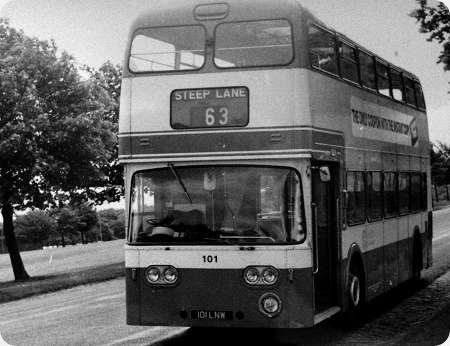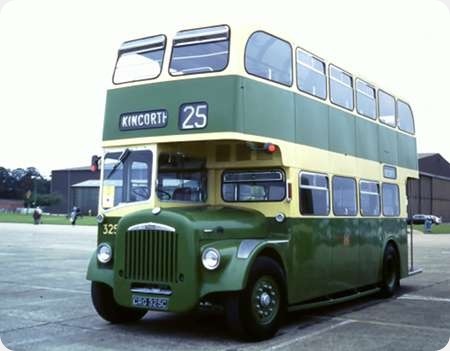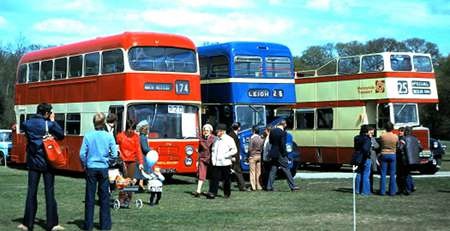Leeds City Transport – Daimler Fleetline – 101 LNW – 101
Leeds City Transport (West Yorkshire PTE)
1964
Daimler Fleetline CRG6LX
Roe H41/29F
In June 1978 West Yorkshire PTE transferred five Fleetlines 101 – 105 from Leeds to Calderdale. 101 was a 1964 Commercial Vehicle Motor Show exhibit which was unique amongst the batch with a single piece curved windscreen and twin headlamps. It is shown here at Skircoat Moor in Halifax shortly before entering service there. One or two points to note, a relatively low seating capacity of 70 when 77 was more normal for this size and layout; note apparently no opening windows in the lower deck (can’t remember this). I do remember the heavy steering and abysmal demisters – this could also affect many other early Fleetlines. The transfer was in the interests of standardisation but this batch had the original ‘heavyweight’ chassis whereas the Halifax buses had the later simplified rear sub frame hence different rear engine mountings – another problem area in early Fleetlines.
Photograph and Copy contributed by Ian Wild
14/01/16 – 16:30
The various early attempts made to ‘prettify’ the boxy shape of the Orion inspired body designs on the first generation Fleetlines and Atlanteans never seemed to come off. Here on this attempt by Roe the lower front panel and curved windscreen seem totally out of context to the remainder which is totally angular. Of the early rear-engined body designs only the Glasgow Alexander version seemed to be designed as a whole and didn’t look like a botch-up. The Bolton East Lancs Atlanteans were pretty good too where the body design seemed to be geared to suit the very attractive livery. It will certainly not be remembered as a high point in British bus bodywork design.
Philip Halstead
14/01/16 – 17:50
I remember 101 well, Ian. My work records show me as having driven it on three occasions at Halifax during 1979. The first was on the 5th January when my conductor Dave Maude and I had it for the first half of a split duty. It is recorded as having been booked off for "No Heaters, No Demisters, Heavy Steering and Slipping Flywheel".
I well remember this occasion as we had struggled to operate a trip to Sowerby with a full standing load of school children for Ryburn Valley High School who unfortunately all insisted on breathing throughout the journey, misting then frosting up our windscreen, Dave having to constantly reach over with bits of paper towel in a vain attempt to provide visibility ahead. Then on the next trip around the 517 Queens Road Circular it became so cold inside that the windscreen froze over on both sides and any attempts to scrape off the ice were thwarted by it immediately freezing over again. We had to finally stop and abandon any hope of continuing the journey for quite a while until I think eventually we were causing such an obstruction that a sympathetic motorist lent us the remains of his de-icer spray and we were just about able to find our way back to Garage in a series of starts and stops.
We also had four more of the batch (102-105), but these had the more conventional flat fronts. They too – like all early Fleetlines – had very heavy steering, but the bodies seemed to be very solid and rattle-free in comparison with the ex-Halifax Northern Counties-bodied Fleetlines, which I thoroughly disliked.
John Stringer
15/01/16 – 06:28
Reading the comments above, I am surprised that no one thought of specifying heated windscreens. I seem to recall them on Hants & Dorset Bristol MWs in the early sixties, which certainly did not have to cope with the more severe weather found in Yorkshire.
David Wragg
15/01/16 – 06:30
101 was the Roe exhibit at the 1964 Earls Court show. Originally finished in traditional Leeds livery plus gold lining out. It was originally fitted with forced ventilation on both decks but following complaints from the public opening windows were fitted in the upper deck.
Like many of LCTs rear engined fleet 101 wore at least three liveries The original the later one man reversed livery and the Metro livery seen here.
On the subject of seating capacity Leeds had no thirty footers with more than 70 seats the largest 33ft deckers only seated 78 The first 30ft types with more than 70 seats were ordered and delivered to the PTE.
Chris Hough
15/01/16 – 14:44
It is not strictly true to say that the first 30ft deckers delivered to Leeds with more than 70 seats were ordered by the P.T.E.
Leylands 221-291, 5221-5291 NW, Daimlers 502-531, 7502-7531 UA and A.E.C.s 910-923, 3910-3923 UB delivered between 1958 and 1960 seated H39/32R when they entered service.
They were altered to H38/32R between August and October 1960 following a National Agreement on standing capacity which meant that buses with more than 70 seats were restricted to a maximum of 5 standing passengers whilst those with not more than 70 could carry 8 standing passengers.
John Kaye
15/01/16 – 17:06
David, the earliest buses I came across with heated windscreens were the final (1969) batch of Plaxton/Roadliners at PMT where we certainly had problems with heaters and demisters (tell me an undertaking that didn’t). You can’t believe the difficulties in getting hot water to flow round 60 feet of pipework.
Ian Wild
16/01/16 – 06:07
Ian. Thought on Roadliners screens were prone to jumping out which only makes demisters the preferred option
Roger Burdett
16/01/16 – 06:12
In that case, Ian, I must have made a mistake. Certainly the Marshall-bodied AEC Reliances of Aldershot & District had such screens around that time, but as regards the Hants & Dorset MWs, put that down to old age!
I can imagine the difficulties in getting heat around vehicles as they grew longer and engines moved from end to the other. More a case of needing a plumber than a mechanic.
David Wragg
16/01/16 – 06:12
Roe never seemed to quite get the "hang of" being able (or could be bothered?) to match-up the top and side profiles of curved windscreens with adjacent body-work, whether single or double-beck – the impression, to me, is of something just cut into bodywork designed for something else. I hope the near-side windscreen wiper was re-fitted before it entered service. And, John, a double-deck on the 517/8 – that was a bit optimistic as regards loadings wasn’t it? with a conductor you must have outnumbered the passenger.
Philip Rushworth
17/01/16 – 06:33
Yes Philip, if I remember rightly there were occasions when we carried nobody at all for the whole round trip, and if not then there were never more than two or three. The service by then was interworked with other routes and this particular AM trip just happened to slot in nicely to a crew operated double-deck working.
Commencing on 9th November,1925 this fairly short circular route served a densely populated area and in its heyday(as the 25 Inner Circle – same number both ways)had been operated by double deckers on a 20 minute (three peaks)or 30 minute (off-peak) frequency, and running throughout the evening. Renumbered 7 (clockwise) or 8 (anti-clocwise) on 24th October 1955 the timetable remained pretty much the same throughout the 1950’s and 60’s. On 29th September 1968 it was combined with the Beechwood Road route becoming cross-town routes 17/18) and converted to OMO single deck operation. The evening service was withdrawn on 27th May 1970. From 20th November 1972 the Beechwood Road section was incorporated into the 3 Hungerhill Estate service, so the 17/18 now reverted to just a Queens Road circular again. On 4th December 1972 it was diverted to also serve Richmond Road, by which time it ran hourly each way. Renumbered 517/518 by WYPTE it was reduced to just four trips per weekday from 12th January 1981, and was withdrawn altogether from 26th October 1986 when the newly created Yorkshire Rider diverted alternate Wainstalls journeys via Queens Road as route 524.
John Stringer
17/01/16 – 06:34
Notably the first C H Roe customer to ask for an Alexander type double curvature windscreen was the then General Manger at Great Yarmouth.
By the time this bus was transferred to Halifax the same man was Engineering Director of the PTE and prior to that he had been General Manager of Halifax and Todmorden.
This shot shows how Roe didn’t put a taper in the front end, unlike Alexander who did: www.flickr.com/photos/johnmightycat/
Stephen Allcroft
17/01/16 – 12:22
That would be the late Geoffrey Hilditch then. A Bus Engineer through and through, the likes of which the Bus Industry will never see again.
Stephen Howarth
17/01/16 – 17:12
Lincoln also bought a batch of Atlanteans with this style of bodywork.
Chris Hough
28/09/20 – 05:33
Reading through all the comments its clear there are some very serious and knowledgeable people that know which brake pads go on which buses.
I am an enthusiast in my own way. I used to be a conductor for Leeds City Transport from 1967 to 1969. Mainly rear loaders (layman’s term) but during that time I remember OMO (one man operated) buses arriving which I was told had been on trial in Leicester I think. At the time these buses were absolute luxury and I remember going to various depots looking for overtime and being thrilled on the front loaders and being a conductor on them. Equally brilliant were the single decker’s which did the inner ring road route. I’m now approaching 70 and can tell anyone and everyone that even after spending 22 years in the Royal Navy and seeing most of the world, being a bus conductor was the proudest job I ever had.
Mike Booth
Quick links to the - Comments Page - Contact Page - Home Page




